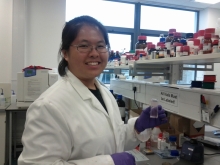
University:
Major:
Site Abroad:
Mentor(s):
Faculty Sponsor(s):
Faculty Sponsor's Department:
Project Title:
Project Description:
Luminescent solar concentrators (LSCs) were introduced over thirty years ago as a means of concentrating solar radiation for improving the cost-effectiveness of photovoltaic cells. LSCs generally consist of a transparent polymer material doped with fluorophores. Incident light is absorbed by the luminescent species and then re-emitted at a longer wavelength. A portion of the re-emitted light is trapped in the LSC by total internal reflection and guided to the edges of the sheet. The light is concentrated as the areas of the edges are smaller than the area of the collector face. In this way, a smaller solar cell can be used while maintaining the same power output but with reduced module cost. Using this same principle, a LSC can be designed for application in wireless optical communications. This would achieve a larger reception area without the need for a larger detector. In our experiment, we fabricated two types of LSCs. The first was comprised of PVA and Ru(BPY)3. These LSC films were made by adding different concentrations of the dye, Ru(BPY)3, into PVA solutions and letting them air-dry in Petri dishes. The other LSC slabs were produced, by way of thermal polymerization, using TPGDA and Rhodamine B. These LSCs were cast in a water bath with AIBN as the initiator. In our tests, re-absorption was found to be the main factor limiting the effectiveness of our LSCs. In order to better understand the LSCs, a program was written to model a LSC and estimate the gain of a LSC based on its dimensions, refractive index and the quantum yield and absorbance spectra of the dye. Optically coupling or casting a photodiode to the edge of a LSC allows us to incorporate the LSC into a data link.
